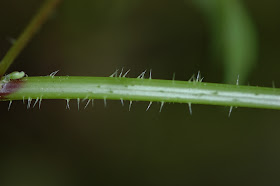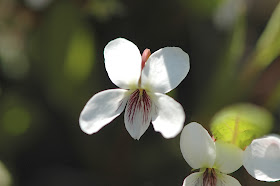Exploring different habitats is the key to diversity. Still hanging on to their blooms is Spring Cress in wet sites, Blue-eyed Mary in moist or mesic sites, and Fire Pink in the drier, sandier sites.
This is a Halictid Bee. They are recognized by their green to gold shiny colors. Halictids are very important pollinators of flowers. Their surface is covered with minute hairs, and you can see all the various white pollen grains stuck to the body. These bees are related to the smaller, often annoying 'sweat bees'. It really wasn't the bee that attracted my attention, but the plant.
I recently posted pictures of Greek Valerian (Jacobs Ladder). Usually purple in color, I came across the 'alba' or white form. This variety is often cultivated, but I never see it in the wild form.
Sitting motionless on the Lycopodium was a Lightningbug or Firefly. The word lightningbug and firefly are often spelled as two separate words, this is incorrect. Fireflies are not flies nor true bugs, but actually Beetles. This lightningbug keeps its head hidden under the thorax.
With a little probing he sticks his head out and starts to walk around. This is a member of the daytime or diurnal firefly family. It has no light colored stripe down the back. The back is blackish-brown, not jet black. The pronotum (thorax) is rimmed in yellow and red-orange. I believe the species is Ellychnia corrusca.
Well he got tired of me bothering him, and decided to take off.
Whorled leaves and four petaled flowers make up one of the many Bedstraw species in our area. This is the largest of them, known as Clinging Cleavers, Galium aparine. It's natures Velcro. The leaves are lined with very fine stiff hairs, and will easily attach to clothing.
Green stripes in the center attract various bees to pollinate the Violet Wood Sorrel, Oxalis violacea. A number of birds are known to feed on the seeds. Literature shows a lot of unusual names associated with this plant such as Purple Stubwort, Indian Lemonade, Sheep Sour, and Fairy Bells.
The leaves are shaped like a shamrock. Purple underneath, they often have purple mottling on the above surface also.
Growing on dry acid soils is another dandelion relative, the Rattlsnake Weed, Hieracium venosum. The purple veins in the leaves make it unmistakeable. Rattlesnake Weed is actually a type of Hawkweed.
While photographing the above plant, this little Red Eft popped it's head out from under the leaves.
Sedum ternatum, the Wild Stonecrop is beginning to come into bloom. Even when not in bloom, the small round clustered leaves that feel very succulent, are easy to recognize. Keying this plant out for the first time, based on the petals, can be difficult. The plant commonly radiates out in at least three directions, but the flowers can show either 4, 5, or 6 petals.
Wild Stonecrop is found in moist to wetter conditions, and so is this beast. While shooting stonecrop, I felt a familiar irritation, Stinging Nettle. Here is a closeup of why they feel so nasty.
Hey, everybody else is posting them, why not me. Years ago I had several different people prepare me a meal of Morels. Never tasted anything so good! I tried repeatedly to copy that, and no matter what, everything I cooked myself tasted like chewing rubber bands. I gave up on them ever since. This was a nice 8-9 incher.
Like a row of turtles sitting on a log, these Whirlygig Beetles were quietly sunning themselves.
Never yell "FIRE" in a crowded beetle theater, they will go paranoid on you. Whirlygigs create a wake when they swim. Their eyes are specially bent or divided so they can see both on the surface and underwater at the same time.
Here was the actual purpose of my trip. This is Lance-leaved Violet, Viola lanceolata. Alex Webb, a former student reported these here a couple years back, but I didn't pay much attention at the time. I now know they are very uncommon in our area. He gave me directions and I found several batches, of all places, on an old coal spill. This species is found in bogs, so the acidic conditions probably contribute to its being here.
The red-purple veins of the center petal make this an attractive species.
Most violets have small rounded leaves. Lance-leaved Violet has elongated, strap like leaves. A population was recently discovered in the Wayne National Forest on the edge of Hocking County. These are also on the Wayne, but in Nelsonville of Athens County. This is probably not a county record, but either way, still an excellent addition to our local flora.



























any chance you can point me in the direction of the Viola lanceolata? I've been focusing on Ohio's violets this Spring and have gotten 20 species but still need this one to make it to 21!
ReplyDeleteAndrew, stop by my office
ReplyDeleteThanks for the excellent directions! I found the patches of the Violets no problem. You weren't kidding about the hike out of there, it certainly got my heart racing! With that one it actually puts me at 22 Ohio Viola's, I miscounted earlier!
ReplyDeleteGreat posts, Dennis! LOVE the little red eft! What luck!
ReplyDelete